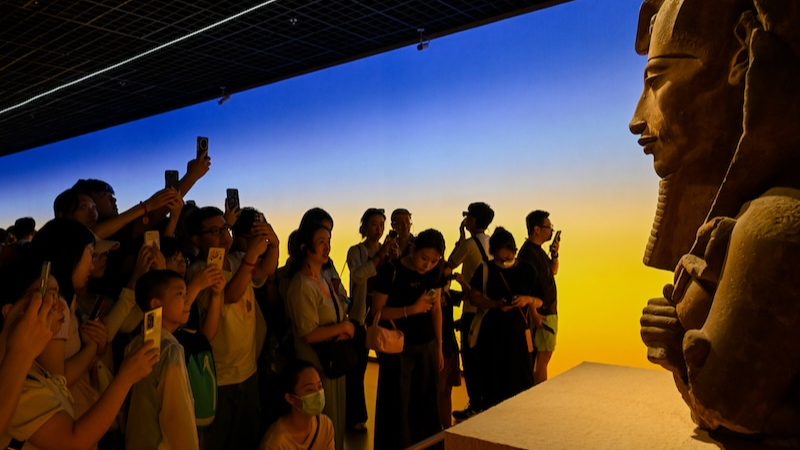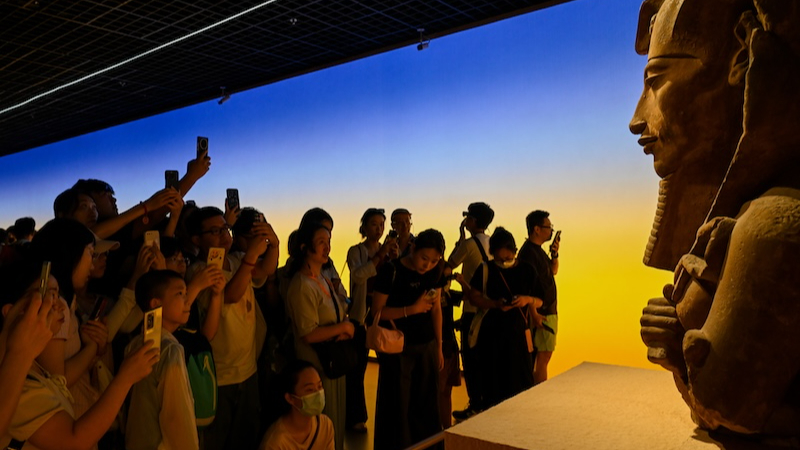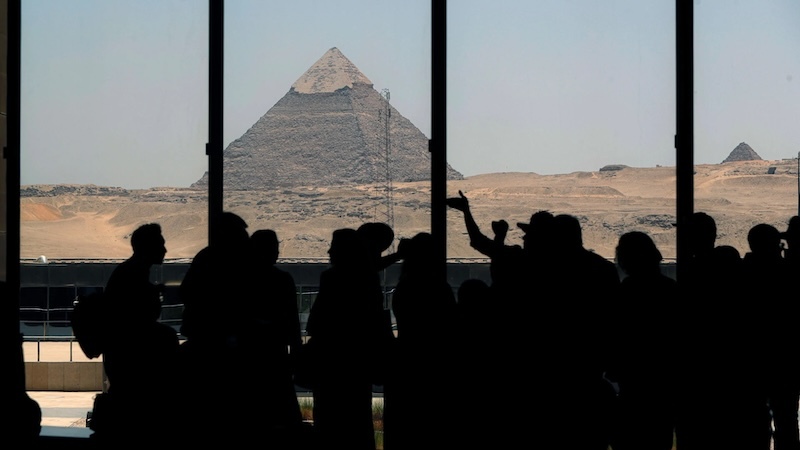
The Shanghai Museum's "Top of the Pyramids: Ancient Egyptian Civilization," which lasted 13 months and spanned two scorching summers, will close at midnight on August 17th. As the exhibition's closing date approaches, visitors continue to flock to the museum. The museum offered a ceremonial farewell with a 168-hour (7-day, 7-night) "Museum Night" event. The exhibition, which lasted 395 days, also broke the global record for attendance at a single paid museum exhibition of cultural relics, exceeding 2.77 million visitors and generating over 760 million yuan in revenue.
What are the little-known stories behind the success of the "2.7 million+" "mega-exhibition"? What was the "traffic secret" behind the "Ancient Egyptian Civilization Exhibition"? What was the key to its success?

As the closing ceremony approaches, crowds continue to pour into the Shanghai Museum. A reporter from The Paper observed long lines outside the museum this afternoon, while the museum's atrium, exhibition halls, and cultural and creative shops all saw record crowds. Before closing tonight (August 17th), the final "Carnival Event" will take place, featuring a parade of NPC gods, Egyptian drum performances, Egyptian dance, a solo acrobatic performance, classic excerpts from the musical "Aida," and a close-up magic show.

Visitors visit the statue of Tutankhamun at the Shanghai Museum on the evening of August 17, 2025. (Photo by Zhu Weihui, reporter of The Paper)

At 9 p.m. on August 17, the "Carnival" of the Ancient Egypt exhibition at the Shanghai Museum. (Photo by Zhu Weihui, reporter of The Paper)
According to the latest data released by the Shanghai Museum, the exhibition set a world record for the number of visitors, total revenue and total dissemination of a single paid special exhibition in museums worldwide with over 2.77 million visitors, a total exhibition revenue of over 760 million yuan and over 30 billion exposures across the entire network. It also had a spillover effect of driving comprehensive urban consumption of over 35 billion yuan, setting a new benchmark for the in-depth integration and development of culture, tourism, commerce, sports and exhibitions.
Chu Xiaobo, director of the Shanghai Museum, said that the success of the Ancient Egyptian Civilization Exhibition not only demonstrates that Chinese museum exhibitions have entered a new era of "super exhibitions", but also provides a "Chinese solution" that can be used as a reference for the exchange and mutual learning of world civilizations.

On August 17, the Shanghai Museum's "Ancient Egyptian Civilization Exhibition" was held. (Photo by Zhu Weihui, a reporter from The Paper)
The "2.77 million" phenomenal exhibition has a huge impact
"Top of the Pyramids: Ancient Egyptian Civilization Exhibition" is the fourth exhibition in the Shanghai Museum's "Dialogue with the World" cultural relics and art series. It is the largest and highest-level ancient Egyptian cultural relics exhibition ever exported from Asia. It is also the first time that a Chinese official museum has cooperated with the Egyptian government to fully reveal the secrets of ancient Egyptian civilization and its latest archaeological discoveries in a world-class cultural relics exhibition. More than 95% of the cultural relics are coming to Asia for the first time.
According to the latest data released by the Shanghai Museum, the exhibition attracted a total of 2,777,966 visitors, setting a new global record for attendance at a single paid special exhibition in a museum. Nearly 70% of these visitors came from other provinces and cities, with over 70% of these visitors coming to Shanghai specifically for the exhibition. Furthermore, driven by the exhibition's continued popularity, the Egyptian Ministry of Tourism and Antiquities reported a 65% year-on-year increase in inbound Chinese tourists. Total exhibition revenue exceeded 760 million yuan, including over 320 million yuan in ticket sales and over 440 million yuan in revenue from cultural and creative activities and related products. According to a statistical analysis report by a professional organization, the Egypt exhibition boosted urban consumption at a ratio of 1:48, driving total urban consumption exceeding 35 billion yuan, a vivid example of "one exhibition energizing a city."

At 9 p.m. on August 17, the "Carnival" of the Ancient Egypt exhibition at the Shanghai Museum. (Photo by Zhu Weihui, reporter of The Paper)

Photo taken by Zhu Weihui, a reporter from The Paper, at the night show on August 11.
The exhibition attracted visitors from across the Yangtze River Delta and across China, with some even flying in from Europe and other places with their cats for the museum's "Meow Night" event. A reporter from The Paper visited the late-night show and found that visitors came from as far away as Jiangsu and Zhejiang, Fujian, Guangdong, Hainan, and even the United States, with the majority having traveled specifically to see the exhibition. The highest proportion of visitors were in their 20s and 30s, followed by teenagers and even younger. Most of these visitors came prepared and prepared, and listening to the guide's explanations was common throughout their visit.

Visitors from Shandong visited the "Age of Tutankhamun" exhibition hall. (Photo by Zhu Weihui, a reporter from The Paper)
For example, Ms. Zheng, who flew from Hainan specifically to see the exhibition, spent nine hours at the museum and five hours listening to a guided tour. Mr. He from Jiangsu visited the exhibition twice within two weeks of its closing, spending nearly ten hours each time. A young couple from Hangzhou brought their own food and spent a full day and night in the exhibition halls.
"The guided tour equipment provided by the Shanghai Museum has been used more than 900,000 times, accounting for one-third of the total number of visitors. This shows that the audience has a deep demand for knowledge and is no longer satisfied with a 'superficial' viewing of exhibitions," said Tang Shifen, Secretary of the Party Committee of the Shanghai Museum.

Photo taken by Zhu Weihui, a reporter from The Paper, at the night show on August 11.
Interestingly, during the 168-hour continuous opening period, some taxi drivers, eager to attract more orders, were known to be "camping" at the Shanghai Museum late into the night. The driver explained that one early morning, he picked up two passengers from Shanghai South Railway Station who said they were going to the Shanghai Museum. "The museum is closed at 1 a.m., so how could there be an exhibition?" the driver exclaimed. The passengers explained that the Shanghai Museum's Ancient Egypt exhibition had been running all night for seven consecutive days, and they had come all the way from far away to see it. "In my over a decade of driving, I've never heard of anything like this," the driver lamented.

On August 17, the Shanghai Museum Cultural and Creative Store (Photo by Zhu Weihui, The Paper)
The continued popularity of the Shanghai Museum exhibition has driven a continued surge in consumption in surrounding areas, including transportation, hotels, restaurants, and shopping. Shanghai Museum Director Chu Xiaobo stated that the exhibition's success has had significant spillover effects. Besides boosting society and the city's economy, it has also significantly enhanced the Shanghai Museum's international influence. For example, thanks to the success of "Top of the Pyramids," Egypt has proactively approached the museum about new exhibition collaborations, prioritizing Shanghai and continuing its collaboration with the Shanghai Museum. The exhibition will also be exhibited at the Hong Kong Palace Museum. The Shanghai Museum has seemingly transitioned from a lender to a resource provider and platform provider, bringing exhibits from Egypt to other parts of the country.
"The Ancient Egyptian Civilization Exhibition is a tough nut to crack."
"China's museum industry is currently experiencing rapid development, with high popularity and enthusiasm. The need for unique and scarce exhibition content is greater than ever. Hosting an exhibition on Ancient Egyptian civilization is a tough nut to crack if the Shanghai Museum is to become a unique museum in China showcasing world civilizations." Chu Xiaobo, in "The Making of the Ancient Egyptian Civilization Exhibition," outlined the original intention of hosting the "Ancient Egyptian Civilization" exhibition. He also revealed that the decision to spend 80 million yuan on an exhibition with an uncertain future was a fierce ideological struggle at the beginning. "With such a high cost, what if the visitor numbers were not ideal? How would we cope?" "No museum in China has ever taken such a risk."

At 0:01 on August 12, visitors lined up to enter the museum. (Photo by Zhu Weihui, reporter of The Paper)
Ultimately, it achieved both economic and social benefits, earning it the title of "a miracle in global exhibition history." What was the "traffic secret" behind the "Ancient Egyptian Civilization Exhibition"? What accounted for its unprecedented series of records?
"On the surface, it seems the Shanghai Museum's exhibition is so popular, but in reality, it's inseparable from the charm of Shanghai, the strong cultural and artistic consumption atmosphere that has been cultivated in Shanghai over the years, and the relevant policy environment." Chu Xiaobo explained the reasons for the successful holding of the Ancient Egypt exhibition and its becoming a top cultural and museum exhibition. "Shanghai has a good policy environment, which allows us to be confident and bold in trying some innovative measures."
From a policy perspective, for example, the exorbitant cost of organizing the Egypt exhibition is practically beyond the Shanghai Museum's means. Where does this funding come from? The bulk of it comes from the revenue generated by the Shanghai Museum's first paid exhibition, "From Botticelli to Van Gogh," held in 2023. "This funding is possible thanks to the Shanghai Municipal Government's pioneering policies—the "Shanghai Public Cultural Facilities Fee Management Measures" and the "Guiding Opinions on Incentives for Cultural and Creative Product Development Income by Shanghai Cultural and Cultural Relics Units," which provide a policy basis for paid exhibitions and encourage cultural and cultural institutions to engage in cultural and creative development, with profits retained for business development, including funding for the introduction of exhibitions."
Secondly, Shanghai's cultural influence and splendid atmosphere of cultural and artistic consumption are key factors as it is a global metropolis. "Shanghai's museums and art galleries consistently host numerous paid exhibitions, stimulating the market and cultivating many experienced young artists. This has fostered a culture of artistic and cultural consumption, creating excellent social conditions for the Shanghai Museum to hold paid exhibitions."

On the evening of August 17, visitors visited the "Painted Humanoid Coffin." (Photo by Zhu Weihui, reporter of The Paper)
The most crucial factor is that the exhibition itself be compelling. Only high-quality content will attract visitors willing to pay for admission. The difficulty of organizing an Egyptian exhibition is widely acknowledged. This exhibition breaks with the traditional model of similar exhibitions relying on loans from European and American museums and presenting them through a Western perspective. Independently curated by the Shanghai Museum and a team of Chinese Egyptologists, it presents an independent narrative through a combination of general history and thematic topics, injecting a Chinese voice into Egyptology and cleverly incorporating Chinese cultural relics into a "dialogue among civilizations."

At 11:10 PM on August 11, the Gods NPC parade. (Photo by Zhu Weihui, reporter of The Paper)
Furthermore, the Shanghai Museum has consistently innovated in its "Ancient Egyptian Civilization" exhibition. For example, the museum launched the first-of-its-kind "Museum Cat Night" event in conjunction with the Egyptian exhibition, allowing visitors to bring their pet cats to the museum at night. The ongoing 168-hour "Carnival" and "Night of Fun at the Museum" have increased the exhibition's popularity and appeal. Furthermore, the museum has leveraged the exhibition's early launch to launch a "one-stop" cultural and tourism experience, implementing numerous innovative initiatives and deeply integrating itself into urban development.
The "Egypt Exhibition" has ended, but the "Egypt Fever" continues
The Shanghai Museum's exhibition also created a significant opportunity for the development of Egyptology. Egyptologists often labeled Egyptology a "less popular" field, often overlooked, but never imagined it would one day find itself at the center of attention. The Shanghai Museum's Ancient Egypt exhibition revitalized this less popular field and sparked a broader interest in Egyptology.
Ms. Hange Elsayed, a representative of the Supreme Council of Antiquities of Egypt, who attended the closing press conference of the "Ancient Egyptian Civilization Exhibition" at the Shanghai Museum, said, "This exhibition has enabled Egyptians and Chinese to engage in a dialogue that transcends language - a dialogue carried out by symbols, art, and memory. It has ignited the inspiration of countless visitors, awakened their curiosity, and cultivated their admiration for ancient civilizations, demonstrating the Chinese people's respect and love for Egypt's cultural heritage." "The leadership of the Supreme Council of Antiquities of Egypt looks forward to strengthening future cooperation in exhibitions, academics, training, and creative projects through this cultural relationship, so as to bring the people of our two countries closer together."

On the evening of August 11, visitors visited the "Age of Tutankhamun" exhibition hall. (Photo by Zhu Weihui, a reporter from The Paper)
Following the Shanghai Museum's "Egypt Exhibition," the Hong Kong Palace Museum will open its "Ancient Egyptian Civilization" exhibition in November, once again sharing the story of ancient Egyptian civilization and attracting new audiences. The exhibition's influence continues, extending beyond a specific time and place.
Thanks to the trusting relationship established with Egypt through the "Egypt Exhibition," the Shanghai Museum has launched a joint Sino-Egyptian archaeological excavation project. Starting in 2025, joint excavations will be conducted at the site of the Temple of Sekhmet near the ancient Egyptian capital of Memphis. This marks the first time a Chinese museum has conducted archaeological excavations in Egypt. The Shanghai Museum will collaborate with the Egyptian National Archaeological Team on a long-term basis, integrating excavations, exhibitions, and museum development, creating a new model of collaboration. "If the exhibition brought ancient Egyptian civilization 'in,' today's archaeological excavations are our 'going out.' We will move from spectators to participants, engaging in a deeper dialogue with this great civilization," said Chen Jie, Deputy Director of the Shanghai Museum.

Members of the Shanghai Museum archaeological team took a photo with local cultural relics officials at the Mukdam site in the delta area
The continued influence and significance of the "Ancient Egyptian Civilization Exhibition" is also reflected in the use of the museum's display platform to transform academic research into popular culture, and the use of the dissemination and popularization of popular culture to promote the research and development of Egyptology. This is a virtuous circle that has achieved good social effects.


